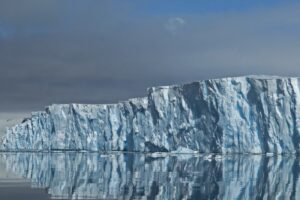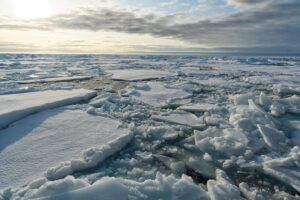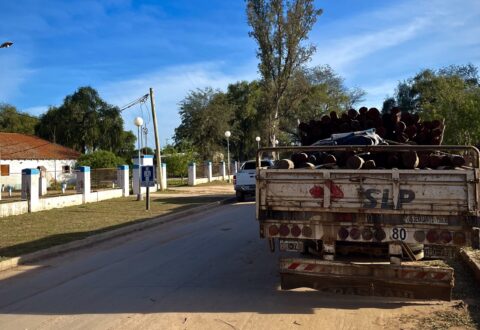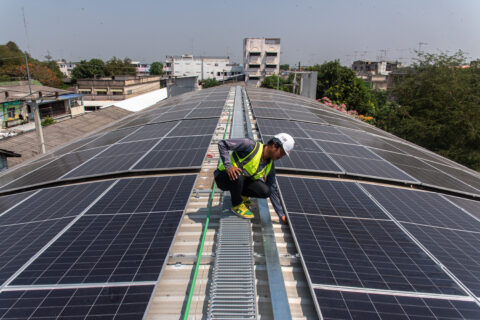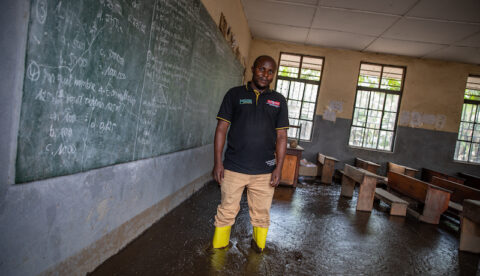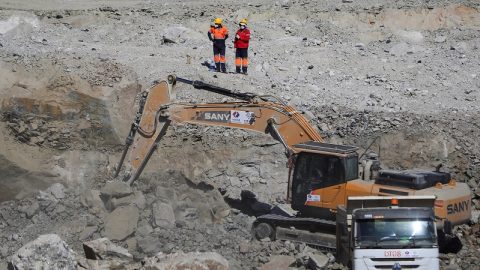Arctic sea ice has recorded its smallest winter peak extent since satellite records began 47 years ago, new data reveals.
Provisional data from the US National Snow and Ice Data Center (NSIDC) shows that Arctic sea ice reached a winter maximum extent of 14.33m square kilometres (km2) last week.
This is 1.31m km2 below the 1981-2010 average maximum and 800,000km2 smaller than the previous low recorded in 2017, according to the data.
Dr Julienne Stroeve, a senior scientist at the NSIDC, tells Carbon Brief that such a small winter peak “doesn’t mean a record-low” summer minimum will necessarily follow in September.
But, she adds, it does “continue the overall long-term decline in the ice cover”.
Meanwhile, Antarctic sea ice reached its summer minimum extent earlier this month, with 2025 tying with 2022 and 2024 for the second-smallest summer low on record, the NSIDC says.
The combination of reduced sea ice cover in both the Arctic and Antarctic means that global sea ice extent dwindled to an “all-time minimum” in February this year, according to the Copernicus Climate Change Service (C3S).
Record low
Arctic sea ice extent changes throughout the year. It grows during the winter towards its annual maximum extent – often referred to as its “winter peak” – in February or March. It then melts throughout the spring and summer towards its September minimum.
Using satellite data, scientists can track the growth and melt of sea ice, allowing them to determine the size of the ice sheet’s winter maximum extent. This is a key way to monitor the “health” of the Arctic sea ice.
On 22 March 2025, Arctic sea ice reached its smallest-ever winter peak, according to the NSIDC. At 14.33m km2, this was 1.31m km2 below the 1981-2010 average maximum and 800,000km2 below the previous low, which was recorded in 2017.
The chart below shows Arctic sea ice extent over the satellite era (1978 to the present day). Red indicates the 2025 extent, while shades of blue indicate different years over 1978-2024.

Daily Arctic sea ice extent (in millions of km2) over the satellite era (1978 to present), where lines indicate individual years. This year is shown in red, while darker blues indicate more recent years. The dashed line indicates the record low winter peak. Credit: Carbon Brief
NSIDC senior research scientist Dr Walt Meier told the Press Association:
“This new record low is yet another indicator of how Arctic sea ice has fundamentally changed from earlier decades. But, even more importantly than the record low, is that this year adds yet another data point to the continuing long-term loss of Arctic sea ice in all seasons.”
Freeze season
The growth season for Arctic sea ice kicked off after reaching its summer minimum extent of 4.28m km2 on 11 September last year. This was the Arctic’s seventh-lowest summer low on record.
As temperatures cooled, the NSIDC says that Arctic sea ice grew slowly at the start of October. Ice growth then sped up towards the middle of the month and then slowed again towards its end. The average sea ice extent for October was 5.94m km2 – the fourth lowest on record, according to the NSIDC.
Throughout November, air temperatures over the Arctic Ocean were “mixed”, according to the NSIDC. It says that temperatures were above average from coastal Canada to northern Scandinavia, as well as in the area north of Greenland, but below average over the Beaufort, Bering and Laptev Seas.

Arctic sea ice grew at a steady pace for most of November – mainly in the Kara, Beaufort and Chukchi Seas, as well as Baffin Bay and the Canadian Arctic archipelago. However, in the Hudson Bay – where air temperatures were 1-5C above average – “no appreciable sea ice” formed, according to the NSIDC.
The November extent averaged 9.11m km2, ranking the third lowest in the satellite record and 1.59mkm2 below the 1981-2010 average, the NSIDC says.
December saw above-average air temperatures over “essentially all of the Arctic Ocean”, with a particularly “prominent” area of warmth off the Canadian Arctic archipelago and Greenland, the NSIDC says.
Due to delayed ice growth in the Hudson Bay and low extent in the northern Barents Sea, December Arctic sea ice extent was the lowest in the satellite record at 11.43m km2.

Daily Arctic sea ice extent decreased sharply at the end of January, when the region lost about 0.3m km2 – an area roughly the size of Italy – in less than a week, according to C3S.
It adds that “such a rapid decrease is unusual at this time of year, when sea ice is typically expanding towards its annual maximum”. It points to the “pronounced warm event” over the Greenland Sea and Svalbard region as the reason for the drop.
Dr Rick Thoman – a specialist in the Alaskan climate from the University of Alaska Fairbanks – tells Carbon Brief that the sea ice decrease in late January and early February was partially driven by “separate cyclones producing simultaneous south winds across much of the Barents and Bering Seas”. As winds pushed the ice northwards, “ocean wave action” melted the thin ice at the edge of the ice sheet, he says.
February was marked by slow Arctic sea ice growth, resulting in a record-low February Arctic sea ice extent of 13.75m km2, according to the NSIDC. The organisation adds that daily sea ice growth “stalled” twice in the month, which “helped to contribute to low ice conditions and led to overall ice retreat in the Barents Sea”.
This rapid melt was partially driven by above-average temperatures. Between northern Greenland and the north pole, temperatures reached up to 12C above average, the NSIDC says.

Antarctic melt
At the south pole, Antarctic sea ice has been declining during the southern hemisphere summer. It reached its annual minimum of 1.98m km2 on 1 March.
This summer low ties with 2022 and 2024 for the second-smallest Antarctic extent in the 47-year satellite record, the NSIDC says. It adds that the past four years are the only years on record in which Antarctic sea ice has reached a minimum below 2m km2.
The graphic below shows Antarctic sea ice extent over the satellite era. Red indicates the 2025 extent and shades of blue indicate different years over 1978-2023.

Daily global sea ice extent (in millions of km2) over the satellite era (1978 to present), where lines indicate individual years. This year is shown in red, while darker blues indicate more recent years. The dashed line indicates the record low. Credit: Carbon Brief
The melt season for Antarctic sea ice began with its winter maximum of 17.2m km2 on 19 September 2024.
This was 1.6m km2 smaller than the 1981-2010 average maximum and the second-lowest winter peak on record, according to the NSIDC.
As the southern hemisphere warmed, Antarctic sea ice began to melt. Throughout October, Antarctic sea ice extent continued to rank the second lowest on the satellite record following the record-breaking 2023 season, the NSIDC says.
It adds that “seasonal ice loss was relatively slow during the early part of the month, but the pace picked up substantially during the last week of October, approaching 2023 values”.
By 30 November, Antarctic sea ice was the third lowest on record, tracking higher than the 2023 and 2016 levels for the same date, the NSIDC says.

After a “prolonged period of record to near-record daily lows set in 2023 and 2024”, December 2024 saw Antarctic sea ice loss slow down, with the average rate of decline tracking “well below average”.
By the end of December 2025, Antarctic sea ice extent was roughly in line with the 1981-2010 average, according to the NSIDC.
As a result, it says that “speculation that the Antarctic had entered a new regime of strongly reduced Antarctic sea ice related to oceanic influences, has, at least temporarily, come to an end”.
It adds that sea ice extent was “above average over the western Weddell and Amundsen Seas and slightly below average in the Ross Sea, with near-average extents in other areas”.
Throughout February, Antarctic sea ice continued to melt – especially in the eastern Ross Sea and Amunsden sea, where ice concentration is low, according to the NSIDC.
Global ‘all-time minimum’
With sea ice at or around record lows in both the Arctic and Antarctic, global sea ice extent dropped to an “all-time minimum” in February this year, according to the Copernicus Climate Change Service (C3S).
Global sea ice hit a new daily low in early February and remained below the previous record from 2023 for the rest of the month, C3S says.
The graphic below shows global sea ice extent over 1978-2025, where red indicates the 2025 extent and shades of blue indicate different years.

Daily Antarctic sea ice extent (in millions of km2) over the satellite era (1978 to present), where lines indicate individual years. This year is shown in red, while darker blues indicate more recent years. The dashed line indicates the record low. Credit: Carbon Brief
C3S deputy director Dr Samantha Burgess noted that the low sea ice came as “February 2025 continues the streak of record or near-record temperatures observed throughout the last two years”. She added:
“One of the consequences of a warmer world is melting sea ice – and the record or near-record low sea ice cover at both poles has pushed global sea ice cover to an all-time minimum.”
The story was picked up in newspapers around the world, including the Guardian, Hindustan Times and Washington Post.
In response to the news from C3DS, Prof Richard Allan – a professor of climate science at the University of Reading – warned that “the long-term prognosis for Arctic sea ice is grim”. He added:
“Averaging over all regions the global warming trend is clear, with February 2025 more than 1.5C above pre-industrial conditions, repeating a level of excess warmth experienced in all but one of the past 20 months despite a weak cooling influence of La Niña conditions in the Pacific.”
The post Arctic sea ice winter peak in 2025 is smallest in 47-year record appeared first on Carbon Brief.
Arctic sea ice winter peak in 2025 is smallest in 47-year record
Climate Change
Colombia proposes expert group to advance talks on minerals agreement
Colombia wants countries to discuss options for a global agreement to ensure that the extraction, processing and recycling of minerals – including those needed for the clean energy transition – don’t harm the environment and human wellbeing.
The mineral-rich nation is proposing to create an expert group to “identify options for international instruments, including global and legally-binding instruments, for coordinated global action on the environmentally sound management of minerals and metals through [their] full lifecyle”.
Colombia hopes this will eventually lead to an agreement on the need for an international treaty to define mandatory rules and standards that would make mineral value chains more transparent and accountable.
The proposal was set out in a draft resolution submitted to the UN Environment Assembly (UNEA) earlier this week and seen by Climate Home News. UNEA, which is constituted of all UN member states, is the world’s top decision-making body for matters relating to the environment. The assembly’s seventh session will meet in Kenya in December to vote on countries’ proposals.
Soaring demand for the minerals used to manufacture clean energy technologies and electric vehicles, as well as in the digital, construction and defence industries have led to growing environmental destruction, human rights violations and social conflict.
Colombia argues there is an “urgent need” to strengthen global cooperation and governance to reduce the risks to people and the planet.
Options for a global minerals agreement
The proposal is among a flurry of initiatives to strength global mineral governance at a time when booming demand is putting pressure on new mining projects.
Colombia, which produces emeralds, gold, platinum and silver for exports, first proposed the idea for a binding international agreement on minerals traceability and accountability on the sidelines of the UN biodiversity talks it hosted in October 2024.
Since then, the South American nation has been quietly trying to drum up support for the idea, especially among African and European nations.
Its draft resolution to UNEA7 contains very few details, leaving it open for countries to discuss what kind of global instrument would be best suited to make mineral supply chains more transparent and sustainable.
Does the world need a global treaty on energy transition minerals?
Colombia says it wants the expert group to build on other UN initiatives, including a UN Panel on Critical Energy Transition Minerals, which set out seven principles to ensure the mining, processing and recycling of energy transition minerals are done responsibly and benefit everyone.
The group would include technical experts and representatives from international and regional conventions, major country groupings as well as relevant stakeholders.
It would examine the feasibility and effectiveness of different options for a global agreement, consider their costs and identify measures to support countries to implement what is agreed.
The resolution also calls for one or two meetings for member states to discuss the idea before the UNEA8 session planned in late 2027, when countries would decide on a way forward.
No time to lose for treaty negotiations
Colombia’s efforts to advance global talks on mineral supply chains have been welcomed by resource experts and campaigners. But not everyone agrees on the best strategy to move the discussion forward at a time when multilateralism is coming under attack.
Johanna Sydow, a resource policy expert who heads the international environmental policy division of the Heinrich-Böll Foundation, said she had hoped that the resolution would explicitly call for negotiations to begin on an international minerals treaty.
“Treaty negotiations take a long time. If you don’t even start with it now, it will take even longer. I don’t see how in two or three years it will be easier to come to an agreement,” she told Climate Home.
Despite the geopolitical challenges, “we need joint rules to prevent a huge race to the bottom for [mineral] standards”. That could start with a group of countries coming together and starting to enforce joint standards for mining, processing and recycling minerals, she said.
But any meaningful global agreement on mineral supply chains would require backing from China, the world’s largest processor of minerals, which dominates most of the supply chains. And with Colombia heading for an election in May, it will need all the support it can get to move its proposal forward.
‘Voluntary initiative won’t cut it’
Juliana Peña Niño, Colombia country manager at the Natural Resource Governance Institute, is more optimistic. “Colombia’s leadership towards fairer mineral value chains is a welcome step,” she told Climate Home News.
“At UNEA7, we need an ambitious debate that gives the proposed expert group a clear mandate to advance concrete next steps — not delay decisions — and that puts the voices of those most affected at the centre. One thing is clear: the path forward must ultimately deliver a binding instrument, as yet another voluntary initiative simply won’t cut it,” she said.
More than 50 civil society groups spanning Latin America, Africa and Europe previously described Colombia’s work on the issue as “a chance to build a new global paradigm rooted in environmental integrity, human rights, Indigenous Peoples’ rights, justice and equity”.
“As the energy transition and digitalisation drive demand for minerals, we cannot afford to repeat old extractive models built on asymmetry – we must redefine them,” they wrote in a statement.
Main image: The UN Environment Assembly is hosted in Nairobi, Kenya. (Natalia Mroz/ UN Environment)
The post Colombia proposes expert group to advance talks on minerals agreement appeared first on Climate Home News.
Colombia proposes expert group to advance talks on minerals agreement
Climate Change
California Sanctions Stark Disparities in Pesticide Exposure During Pregnancy
If you’re young, pregnant and Latina, chances are you live near agricultural fields sprayed with higher levels of brain-damaging organophosphate pesticides.
A baby in the womb has few defenses against industrial petrochemicals designed to kill.
California Sanctions Stark Disparities in Pesticide Exposure During Pregnancy
Climate Change
DeBriefed 3 October 2025: UK political gap on climate widens; Fossil-fuelled Typhoon Ragasa; ‘Overshoot’ unknowns
Welcome to Carbon Brief’s DeBriefed.
An essential guide to the week’s key developments relating to climate change.
This week
Shattered climate consensus
FRACKING BAN: UK energy secretary Ed Miliband has announced that the government will bring forward its plans to permanently ban fracking, in a move designed to counter a promise from the hard-right Reform party to restart efforts to introduce the practice, the Guardian said. In the same speech, Miliband said Reform’s plans to scrap clean-energy projects would “betray” young people and future generations, the Press Association reported.
ACT AXE?: Meanwhile, Kemi Badenoch, leader of the Conservatives, pledged to scrap the 2008 Climate Change Act if elected, Bloomberg reported. It noted that the legislation was passed with cross-party support and strengthened by the Conservatives.
‘INSANE’: Badenoch faced a backlash from senior Tory figures, including ex-prime minister Theresa May, who called her pledge a “catastrophic mistake”, said the Financial Times. The newspaper added that the Conservatives were “trailing third in opinion polls”. A wide range of climate scientists also condemned the idea, describing it as “insane”, an “insult” and a “serious regression”.
Around the world
- CLIMATE CRACKDOWN: The US Department of Energy has told employees in the Office of Energy Efficiency and Renewable Energy to avoid using the term “climate change”, according to the Guardian.
- FOREST DELAY: Plans for Brazil’s COP30 flagship initiative, the tropical forests forever fund, are “suffer[ing] delays” as officials remain split on key details, Bloomberg said.
- COP MAY BE ‘SPLIT’: Australia could “split” the hosting of the COP31 climate summit in 2026 under a potential compromise with Turkey, reported the Guardian.
- DIVINE INTERVENTION: Pope Leo XIV has criticised those who minimise the “increasingly evident” impact of global warming in his first major climate speech, BBC News reported.
€44.5 billion
The cost of extreme weather and climate change in the EU in the last four years – two-and-a-half times higher than in the decade to 2019, according to a European Environment Agency report covered by the Financial Times.
Latest climate research
- Fossil-fuelled climate change caused around 36% of Typhoon Ragasa’s direct damage to homes and properties in southern China, according to a rapid impact attribution study | Imperial Grantham Institute – Climate Change and the Environment
- Some 86% of the global population are concerned about climate change, according to a survey of 280,000 people in 142 countries and regions | Climate Policy
- A global shift towards a “planetary health diet” could slash emissions and save tens of thousands of lives each day | EAT-Lancet Commission 2025 report
(For more, see Carbon Brief’s in-depth daily summaries of the top climate news stories on Monday, Tuesday, Wednesday, Thursday and Friday.)
Captured

Clean energy has met 100% of Great Britain’s electricity demand for a record 87 hours this year so far, according to new Carbon Brief analysis. This is up from just 2.5 hours in 2021 and 64.5 hours in all of 2024. The longest stretch of time where 100% of electricity demand was met by clean energy stands at 15 hours, from midnight on 25 May 2025 through to 3pm on 26 May, according to the analysis.
Spotlight
‘Overshoot’ unknowns
As the chances of limiting global warming to 1.5C dwindle, there is increasing focus on the prospects for “overshooting” the Paris Agreement target and then bringing temperatures back down by removing CO2 from the atmosphere.
At the first-ever Overshoot Conference in Laxenburg, Austria, Carbon Brief asks experts about the key unknowns around warming “overshoot”.
Sir Prof Jim Skea
Chair of the Intergovernmental Panel on Climate Change (IPCC) and emeritus professor at Imperial College London’s Centre for Environmental Policy
So there are huge knowledge gaps around overshoot and carbon dioxide removal (CDR). As it’s very clear from the themes of this conference, we don’t altogether understand how the Earth would react in taking CO2 out of the atmosphere.
We don’t understand the nature of the irreversibilities and we don’t understand the effectiveness of CDR techniques, which might themselves be influenced by the level of global warming, plus all the equity and sustainability issues surrounding using CDR techniques.
Prof Kristie Ebi
Professor at the University of Washington’s Center for Health and the Global Environment
There are all kinds of questions about adaptation and how to approach effective adaptation. At the moment, adaptation is primarily assuming a continual increase in global mean surface temperature. If there is going to be a peak – and of course, we don’t know what that peak is – then how do you start planning? Do you change your planning?
There are places, for instance when thinking about hard infrastructure, [where overshoot] may result in a change in your plan – because as you come down the backside, maybe the need would be less. For example, when building a bridge taller. And when implementing early warning systems, how do you take into account that there will be a peak and ultimately a decline? There is almost no work in that. I would say that’s one of the critical unknowns.
Dr James Fletcher
Former minister for public service, sustainable development, energy, science and technology for Saint Lucia and negotiator at COP21 in Paris.
The key unknown is where we’re going to land. At what point will we peak [temperatures] before we start going down and how long will we stay in that overshoot period? That is a scary thing. Yes, there will be overshoot, but at what point will that overshoot peak? Are we peaking at 1.6C, 1.7C, 2.1C?
All of these are scary scenarios for small island developing states – anything above 1.5C is scary. Every fraction of a degree matters to us. Where we peak is very important and how long we stay in this overshoot period is equally important. That’s when you start getting into very serious, irreversible impacts and tipping points.
Prof Oliver Geden
Senior fellow and head of the climate policy and politics research cluster at the German Institute for International and Security Affairs and vice-chair of IPCC Working Group III
[A key unknown] is whether countries are really willing to commit to net-negative trajectories. We are assuming, in science, global pathways going net-negative, with hardly any country saying they want to go there. So maybe it is just an academic thought experiment. So we don’t know yet if [overshoot] is even relevant. It is relevant in the sense that if we do, [the] 1.5C [target] stays on the table. But I think the next phase needs to be that countries – or the UNFCCC as a whole – needs to decide what they want to do.
Prof Lavanya Rajamani
Professor of international environmental law at the University of Oxford
I think there are several scientific unknowns, but I would like to focus on the governance unknowns with respect to overshoot. To me, a key governance unknown is the extent to which our current legal and regulatory architecture – across levels of governance, so domestic, regional and international – will actually be responsive to the needs of an overshoot world and the consequences of actually not having regulatory and governance architectures in place to address overshoot.
Watch, read, listen
FUTURE GAZING: The Financial Times examined a “future where China wins the green race”.
‘JUNK CREDITS’: Climate Home News reported on a “forest carbon megaproject” in Zimbabwe that has allegedly “generated millions of junk credits”.
‘SINK OR SWIM’: An extract from a new book on how the world needs to adapt to climate change, by Dr Susannah Fisher, featured in Backchannel.
Coming up
- 7 October: International Energy Agency (IEA) renewables 2025 report launch
- 8-10 October: World summit of Indigenous peoples and nature, Abu Dhabi, UAE
- 9-15 October: International Union for the Conservation of Nature (IUCN) 2025 congress, Abu Dhabi, UAE
Pick of the jobs
- UK government foreign, commonwealth and development office, senior climate policy adviser | Salary: CA$93,207. Location: Calgary, Canada
- Wellcome Trust, senior research manager, climate and health | Salary: £64,800. Location: London
- Bloomberg, product manager – climate, nature and sustainability regulations | Salary: Unknown. Location: London
DeBriefed is edited by Daisy Dunne. Please send any tips or feedback to debriefed@carbonbrief.org.
This is an online version of Carbon Brief’s weekly DeBriefed email newsletter. Subscribe for free here.
The post DeBriefed 3 October 2025: UK political gap on climate widens; Fossil-fuelled Typhoon Ragasa; ‘Overshoot’ unknowns appeared first on Carbon Brief.
-
Climate Change2 years ago
Spanish-language misinformation on renewable energy spreads online, report shows
-
Climate Change Videos2 years ago
The toxic gas flares fuelling Nigeria’s climate change – BBC News
-
Climate Change2 months ago
Guest post: Why China is still building new coal – and when it might stop
-

 Greenhouse Gases1 year ago
Greenhouse Gases1 year ago嘉宾来稿:满足中国增长的用电需求 光伏加储能“比新建煤电更实惠”
-

 Climate Change1 year ago
Climate Change1 year ago嘉宾来稿:满足中国增长的用电需求 光伏加储能“比新建煤电更实惠”
-
Greenhouse Gases2 months ago
Guest post: Why China is still building new coal – and when it might stop
-

 Carbon Footprint1 year ago
Carbon Footprint1 year agoUS SEC’s Climate Disclosure Rules Spur Renewed Interest in Carbon Credits
-
Renewable Energy3 months ago
US Grid Strain, Possible Allete Sale


